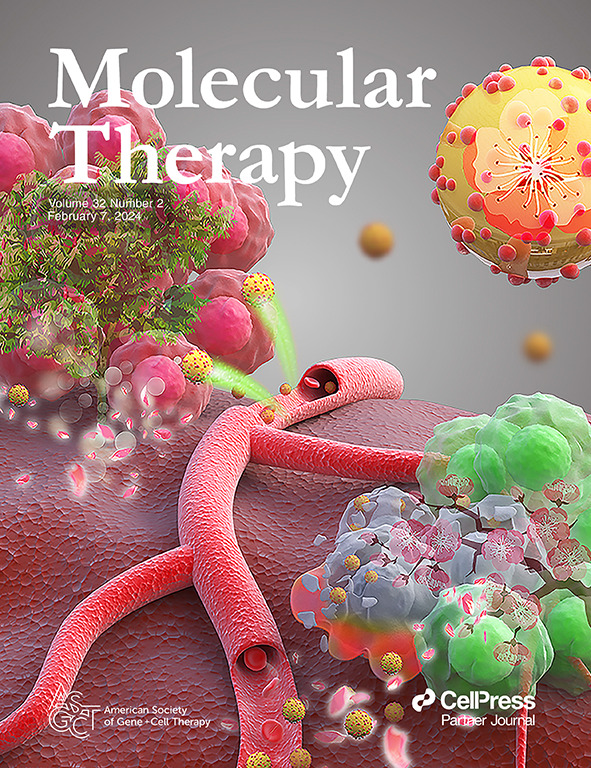ErbB2/HER2-targeted CAR-NK cells eliminate breast cancer cells in an organoid model that recapitulates tumor progression.
IF 12.1
1区 医学
Q1 BIOTECHNOLOGY & APPLIED MICROBIOLOGY
引用次数: 0
Abstract
Chimeric antigen receptor-engineered NK cells hold promise for adoptive cancer immunotherapy. In one such approach, the ErbB2 (HER2)-specific CAR-NK cell line NK-92/5.28.z is under investigation as an off-the-shelf therapy in a phase I trial in glioblastoma patients. To evaluate activity of NK-92/5.28.z cells against ErbB2-positive breast cancer, here we developed an organoid model derived from CKP mice that allows conditional activation of oncogenic driver mutations. Expression of ErbB2 and Cre recombinase in CKP mammary epithelial cells induced malignant transformation, with the resulting EC-CKP cells characterized by neoplastic morphology, loss of p53 and constitutive activation of the MAP kinase pathway. NK-92/5.28.z cells demonstrated potent CAR-mediated cytotoxicity against EC-CKP organoids, with tumor cell lysis dependent on exposure time and organoid size. In vivo passaging of EC-CKP organoids revealed cellular plasticity and induced an EMT phenotype associated with increased resistance to standard therapies. Importantly, NK-92/5.28.z cells retained high and specific cytotoxicity against these breast cancer cells in vitro and in an aggressive organoid-based in vivo mouse model that reflects advanced-stage disease. Our data highlight the therapeutic potential of NK-92/5.28.z cells against ErbB2-positive breast cancer, supporting their further development toward clinical application.在一个再现肿瘤进展的类器官模型中,ErbB2/ her2靶向CAR-NK细胞消除乳腺癌细胞。
嵌合抗原受体工程NK细胞有望过继性癌症免疫治疗。其中一种方法是ErbB2 (HER2)特异性CAR-NK细胞系NK-92/5.28。z作为一种现成的治疗方法正在胶质母细胞瘤患者的I期临床试验中进行研究。评价NK-92/5.28的活性。在此,我们开发了一种源自CKP小鼠的类器官模型,该模型允许有条件地激活致癌驱动突变。在CKP乳腺上皮细胞中表达ErbB2和Cre重组酶可诱导恶性转化,产生EC-CKP细胞,其特征是肿瘤形态、p53缺失和MAP激酶途径的组成性激活。NK-92/5.28。z细胞对EC-CKP类器官显示出强大的car介导的细胞毒性,肿瘤细胞裂解依赖于暴露时间和类器官大小。EC-CKP类器官的体内传代揭示了细胞的可塑性,并诱导了与对标准治疗的抗性增加相关的EMT表型。重要的是,NK-92/5.28。在体外和反映晚期疾病的侵袭性类器官小鼠体内模型中,Z细胞对这些乳腺癌细胞保持了高和特异性的细胞毒性。我们的数据突出了NK-92/5.28的治疗潜力。z细胞对抗erbb2阳性乳腺癌,支持其进一步发展临床应用。
本文章由计算机程序翻译,如有差异,请以英文原文为准。
求助全文
约1分钟内获得全文
求助全文
来源期刊

Molecular Therapy
医学-生物工程与应用微生物
CiteScore
19.20
自引率
3.20%
发文量
357
审稿时长
3 months
期刊介绍:
Molecular Therapy is the leading journal for research in gene transfer, vector development, stem cell manipulation, and therapeutic interventions. It covers a broad spectrum of topics including genetic and acquired disease correction, vaccine development, pre-clinical validation, safety/efficacy studies, and clinical trials. With a focus on advancing genetics, medicine, and biotechnology, Molecular Therapy publishes peer-reviewed research, reviews, and commentaries to showcase the latest advancements in the field. With an impressive impact factor of 12.4 in 2022, it continues to attract top-tier contributions.
 求助内容:
求助内容: 应助结果提醒方式:
应助结果提醒方式:


